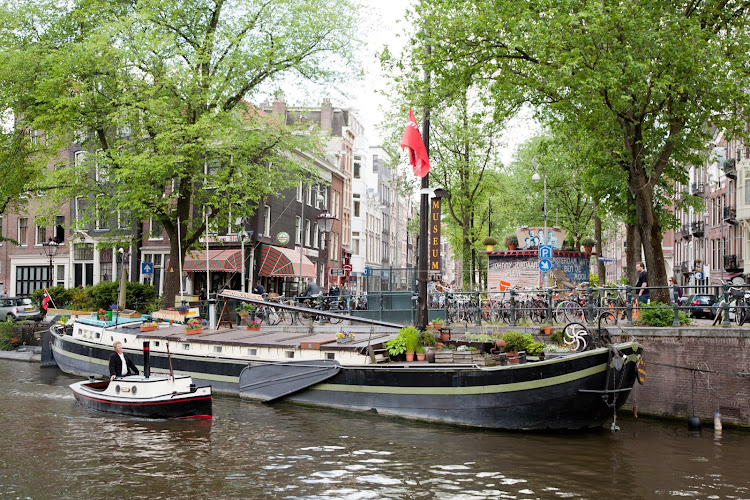A genuine Amsterdam experience awaits at the Houseboat Museum (Woonbootmuseum), where visitors can explore authentic life on Amsterdam’s iconic canals. Located on the historic Prinsengracht canal in the charming Jordaan district, the museum is housed within the hull of the “Hendrika Maria,” a converted cargo vessel that offers visitors a rare glimpse into Dutch canal boat living. Just a five-minute walk from the Anne Frank House, this floating exhibition allows you to step directly into a fully-furnished houseboat, experiencing firsthand the unique lifestyle that defines Amsterdam’s waterways and city culture.
From Cargo Ship to Floating Home: The History of Amsterdam Houseboats
The Hendrika Maria has a rich history that mirrors Amsterdam’s evolving relationship with its canals. Built in 1914, this 23-meter vessel began its life as a freighter, transporting goods such as sand, coal, and timber throughout the Dutch waterways. During World War II, the ship was deliberately sunk to prevent it from falling into German hands—a small but significant act of resistance.
After the war, Amsterdam faced a severe housing shortage, and cargo vessels became obsolete due to fleet modernization, so Hendrika Maria found a new purpose. In 1967, it was converted into a residential houseboat, joining the more than 2,500 floating homes that line Amsterdam’s canals today. This transformation reflects a broader cultural shift in the city: what began as practical housing solutions born of necessity evolved into sought-after Amsterdam homes that now represent a distinct way of life in the Dutch capital.
Vincent van Loon initiated the final transformation of this historic vessel in 1996, converting the Hendrika Maria into the museum we see today—the only one of its kind in the world dedicated to preserving this unique aspect of Amsterdam’s living heritage.
Life in a Floating Space: Inside an Amsterdam Canal Boat Home
The museum expertly showcases the ingenious use of space that defines Amsterdam canal houseboat living. The former cargo hold has been transformed into a surprisingly spacious and comfortable living room with a distinct 1970s aesthetic, challenging common preconceptions about canal boat living being cramped or primitive. Natural light streams through long glass strips in the raised roof, creating a bright, welcoming atmosphere within the 80m² of living space carved from the vessel’s hull.
A particular highlight is the contrast between the main living quarters and the original skipper’s area at the stern. While the main space demonstrates modern canal living, the preserved skipper’s quarters reveal how a family of four once lived in an incredibly compact space with traditional Dutch “cupboard beds” built into the sides of a meter-high hallway. This juxtaposition offers visitors a fascinating timeline of Dutch canal boats that have lived through the decades.
The compact kitchen and functional bathroom demonstrate how everyday amenities are intelligently integrated into the boat’s structure. Every corner of the space serves a purpose, showcasing the practical yet comfortable reality of houseboat life in Amsterdam. The museum also addresses the practical aspects of living on water that visitors often wonder about—how houseboats connect to utilities, manage waste, and maintain stability on the canals.
Why Visit the Amsterdam Houseboat Museum?
For anyone curious about Amsterdam’s unique relationship with water, the Houseboat Museum answers questions that arise when admiring the city’s 2,500 floating homes from canal bridges or boat tours. How are houseboats supplied with water and electricity? What does daily life look like within these floating spaces? Is it cold or damp inside? How do people adapt to life on the water?
The museum offers a hands-on experience not found elsewhere in Amsterdam. Visitors are encouraged to touch, sit, and truly inhabit the space, creating a connection to Amsterdam’s canal culture that passive observation cannot provide. Multi-language audio guides (available in English, German, Dutch, French, Spanish, Portuguese, Chinese, and Italian) provide context. At the same time, exhibits explain practical aspects of houseboat maintenance, including the mandatory shipyard visits every six years for hull integrity checks.
Beyond satisfying curiosity, the museum preserves an important part of Amsterdam’s heritage. As traditional cargo-vessel houseboats (woonschepen) become increasingly rare compared to modern floating homes (arken), the Hendrika Maria is a tangible link to the city’s maritime past and the evolving story of canal living. Today, living on an Amsterdam houseboat is no longer a budget option but often more expensive than a conventional apartment, with prime locations commanding significant prices.
The museum’s location adds to its appeal. It is just a five-minute walk from the Anne Frank House in the charming Jordaan district, one of Amsterdam’s most picturesque neighborhoods. At approximately 30 minutes to explore, it makes an ideal addition to your Amsterdam itinerary—a brief yet insightful dive into a distinctive aspect of Dutch urban life that has become an iconic symbol of the city.
Plan Your Visit to the Houseboat Museum
Location: Prinsengracht 296 K, 1016 HW Amsterdam
Hours: Daily 10:00 AM – 5:00 PM (verify current hours on their official website)
Admission: Adults €9.50, Children (5-12) €5.00, Under 5 free
Tip: Visit between 10:00 AM and 12:00 PM for a morning discount (€8.00)
Access: Several tram lines (13, 17 to Westermarkt, or 5 to Elandsgracht) stop nearby. A 20-30 minute walk from Amsterdam Central Station.
I Amsterdam City Card and GoCity Pass holders enjoy free entry, making the museum excellent value for those with these passes.
Frequently Asked Questions
How long does it take to visit the Houseboat Museum?
Most visitors spend about 30 minutes exploring the museum, making it an easy addition to your Amsterdam itinerary.
Is the Houseboat Museum accessible to people with mobility issues?
Due to the authentic nature of the vessel, accessing the boat involves steep stairs, which may present difficulties for individuals with mobility impairments.
Can I take photographs inside the museum?
Yes, photography is permitted, but without flash to preserve the interior.
Is the museum suitable for children?
Children often enjoy exploring the unique space of the houseboat. The skipper’s quarters’ compact “cupboard beds” fascinate young visitors.
What makes the Houseboat Museum different from other Amsterdam museums?
As the only floating museum in the world, it offers a rare opportunity to experience authentic canal boat living from the inside rather than just viewing houseboats from the outside.

